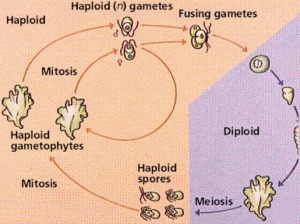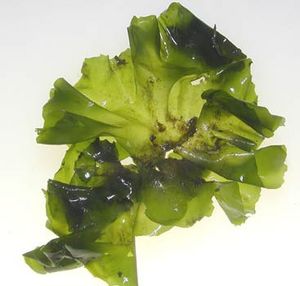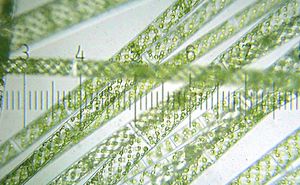Chlorophyta: Difference between revisions
(Added an image.) |
|||
| Line 20: | Line 20: | ||
==Description and Significance== | ==Description and Significance== | ||
[[Image:20090523_213732_Spirogyra.jpg|thumb|300px|right|<i>Spirogyra.</i><br/>Numbered ticks are 122 µM apart.<br>Photograph by [[User:Blaylock|Bob Blaylock]]]] | [[Image:20090523_213732_Spirogyra.jpg|thumb|300px|right|<i>Spirogyra.</i><br/>Numbered ticks are 122 µM apart.<br>Photograph by [[User:Blaylock|Bob Blaylock]].]] | ||
Chlorophyta are commonly known as green algae. This is the most diverse group of algae, with over 7,000 species. Chlorophyta are a paraphyletic group. They are the sister group to Microthmaniales. | Chlorophyta are commonly known as green algae. This is the most diverse group of algae, with over 7,000 species. Chlorophyta are a paraphyletic group. They are the sister group to Microthmaniales. | ||
Revision as of 08:06, 24 July 2010
A Microbial Biorealm page on the phylum Chlorophyta
Classification
Higher order taxa:
Eukaryota; Viridiplantae
Species:
Ulva lobata, Caulerpa racemosa, Spirogyra insignis
|
NCBI: Taxonomy Genome |
Description and Significance
Chlorophyta are commonly known as green algae. This is the most diverse group of algae, with over 7,000 species. Chlorophyta are a paraphyletic group. They are the sister group to Microthmaniales.
Genome Structure
There are many different species belonging to Chlorophyta; some are unicellular, some are multicelluar. The genome structures within Chlorophyta are all different. However, there are some common characteristics across species. For example, one of the ways to identify Chlorophyta is by their small subunit rDNA.
Cell Structure and Metabolism

Most Chlorophyta are unicelluar, but there are some multicelluar species. Some are free-living, some are colonial, others are coenocytic. Glucosamine is the main component of cells walls in Chlorophyta. Filamentous sporophytes have singluar lenticular nuclei, which are embedded in a thick cytoplasm. Chlorophyta usually have biflagellated gametes. Like other green plants, Chlorophyta contain chlorophylls a and b, although the major pigment is chlorophyll b. In addition, some tropical species are pigmented by siphonoxanthin and siphonein. They store starches made from photosynthesis in double-membrane bounded chloroplasts. Cell walls are made of cellulose.
Chlorophyta are photosynthetic organisms, obtaining starch from photosynthesis. They are autotrophic.
Chlorophyta reproduce both sexually and asexually, but usually sexually. Asexual reproduction can occurs by fission, fragmentation, or zoospores. Sexual reproduction can be isogamous, anisogamous, or oogamous. The species Ulva lobata experiences alternation of generations, alternating between haploid and diploid phases. In the haploid phase, gametes are formed; in the diploid phase, zoospores are formed. Not all species have this, however. For the species without alternation, meiosis occurs in the zygote.
Ecology
Cholorophyta are adapted to shallow water, and live in both freshwater and marine habitats. 90% of Chlorophyta are freshwater species. Those that live in marine habitats largely inhabit tropical environments. There are a small number of terrestrial species; these largely dwell on rocks or trees. Some species form symbiotic relationships with fungi, producing lichens. There are a few instances in which Chlorophyta have formed symbiotic relationships with animals.
The Chlorophyta species Caulerpa racemosa was introduced to the Mediterranean Sea in 1990. It was first observed in France in 1997, and has continued spreading. Many of the invaded locations are fishing areas. The Mediterranean Sea has many environmental factors that encourage the growth of Caulerpa racemosa, such as an ideal climate and substrata.
The species Spirogyra insignis is known to adapt to harsh conditions through spontaneous mutation. Flores-Moya et. al. (2005) studied the adaptation of this species in sulpherous waters. At first, its growth and reproduction was inhibited. However, the culture survived due to the growth of a resistant variant that formed before the culture was introduced to these sulfurous waters. This type of spontaneous mutation is what allows the species to survive.
References
Abedon, Stephen T. "Kingdom" Chlorophyta.
Guiry, Michael. Chlorophyta: Green Algae.
Patterson, David J. "Algae: Protists with Chloroplasts." The Tree of Life Web Project.
Smith, Celia. Division Chlorophyta.
Solorzano, Luis A. and Warren E. Savary. The California Biota Website.



